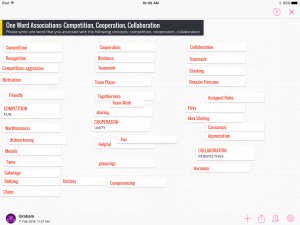When I view the relationship of competition in schools to collaboration among students, something that stands out in the forefront for me is how collaboration can permeate through team sports. This may seem like a contradiction and that many would argue that the two are mutually exclusive, however in the experience witnessing how some amazing educators have worked tirelessly to create a sense of collaborative competitiveness, I believe that it is possible. I believe it is completely dependent on the framework and presentation of the competition, and if it is done correctly can lead to an amazing atmosphere; one of enthusiasm, motivation, encouragement, growth, comfort, and a consideration of the feelings of the participants.
The scenario where I have witnessed this the most is during my practicum in the basketball program led by teachers and coaches from around the district. The structure for this is that the students are learning, and let me stress that they are LEARNING, how to play the sport. Inherit in this is competition as it is indeed a sport, however there are many other aspects to it that cross over with competition, most noticeably is the idea of cooperation. They are acting together as a team, communicating with peers, and working towards achieving a goal (winning the game). This is the definition of cooperation and one that is prevalent throughout team sports. However, more rare than this is collaboration within team sports. This is a much loftier goal as it requires collaboration among all participants, not just “your team”. Communication, working towards a goal, and trust are all elements that need to be shared between your team, your coaches, the other team, the other coaches, the referees, the spectators, everyone! Now how could this possible exist in such a competitive, no-holds-barred, free-for-all world like elementary basketball? Well it can, and here’s how. In watching the students engage in the sport, the coaches/referees conducted the game in a very unique way and one that didn’t reflect the “traditional” nature of competition. During the play, whenever there was a foul, the coaches/referees called the foul but didn’t simply continue on with the game. They stopped, drew all the players in regardless of which team they were associated with, and took the time to explain the play, what went wrong, and how to correct it next time. They demonstrated the concept and checked for comprehension with all the players. They then restarted the game and play continued with the coaches/referees continuing this trend of stop, collaborate, start, compete. This is a system that the students really responded to. It allowed them to participate in the traditional, competitive environment, however still leaving room for collaborative reinforcement of areas to improve on. Through this, you could really see the impact collaborative competition can have on the students. They were engaged yet exhibited sportsmanship, motivated to do their best yet respectful, honoured the process but showed that drive to succeed.
So can collaborative competition work? Absolutely! Is it effective? You betcha! Is it dependent on the framework you set up at the beginning of the activity and a prerequisites of skills the participants need to have before starting? Also yes. Regardless, it is a system that incorporates the best of both worlds and one certainly worth of exploring.
(Side Note: I know “play ball” is most often associated with baseball and this reflection was on basketball, but the title was too good to pass up)
